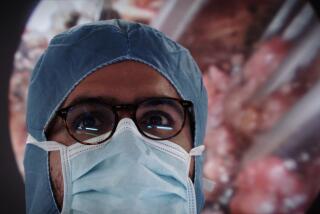Getting to Know Your Entire Body of Work
- Share via
As convicted murderer John Paul Jernigan ate his last meal--two cheeseburgers and fries--in 1993, he couldn’t have known that he would one day be a digital superstar.
A little later, Jernigan was executed by the state of Texas. Before he died, he signed a donor consent authorizing scientific use of his body.
Some speculated he wanted to do something of merit before he died. The district attorney who prosecuted the brutal slaying of an elderly man who arrived home while Jernigan was robbing his house thought the reasons were more practical: “No one in his family was going to pay to bury him.”
Jernigan’s body was flown to a University of Colorado lab where a team had been searching for two years for an ideal subject for the federally funded Visible Human Project. Their goal was to use computer imaging to make the most complete representation of a human body in history.
Jernigan’s age, 39, and condition were ideal. His body had not been badly damaged during death--the execution was by lethal injection (about a half-year later, they also found an ideal female.)
The researchers scanned his body, using rotating X-rays and magnetic resonance imaging, and then cut it, horizontally, into four sections. These sections were frozen and then sliced into 1 millimeter cross-sections. When they were finished, John Paul Jernigan was in more than 1,800 pieces, each painstakingly photographed.
The primary purpose of the project was to create information that could be sent via computer networks to surgeons, researchers and educators worldwide.
But while the project was ongoing, the digital world was evolving rapidly, and the use of sophisticated digital imagery had moved into homes via the Internet and CD-ROMs. Now, anyone with either of these can access the Visible Human.
On the Web, the Visible Human’s home is https://www.nlm.nih.gov/research/visible/visible--human.html, where you’ll find links to sample images and animations produced by the project. You can also arrange to download the complete set of images, but it will cost $1,000.
For only $30, the consumer can get a less complete but still astonishing view on CD-ROM. And it has the advantage of being far more user friendly than the Internet site. BodyVoyage, recently released by Time Warner Electronic Publishing for the Macintosh and Windows formats, presents the images in renderings created and organized for the lay person by noted medical photographer Alexander Tsiaras.
The main part of the CD-ROM is divided into sections: full body, head, torso, pelvis and legs. In these sections, you can choose individual body parts to examine. Using your mouse, you can rotate them to view from various angles or explore all the way down to the bone.
The renderings are no less than thrilling. I only wish the CD-ROM had gone further in its educational aspects. But it seems a bit crass to quibble. The fact that it simply exists is emblematic of the wonders that the digital revolution has brought into our homes.
* Cyburbia’s e-mail address is [email protected].






